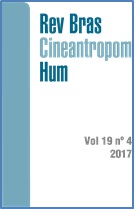Desempenho isocinético de flexores e extensores de joelho em jogadores de futebol americano do Brasil
DOI:
https://doi.org/10.1590/1980-0037.2017v19n4p426Resumo
O desempenho isocinético dos músculos da coxa é associado com o desempenho atlético
e com o risco de lesões sem contato físico. Apesar de o perfil isocinético dos jogadores de futebol americano que atuam nos Estados Unidos (EUA) ser amplamente pesquisado, poucos são os estudos com atletas fora dos EUA. O objetivo primário desse estudo era descrever o desempenho isocinético dos atletas de futebol americano no Brasil. Além disso, buscamos comparar as posições de jogo e comparar os de elite brasileiros e americanos. Os músculos extensores (EXT) e flexores (FLE) de joelho de 72 jogadores brasileiros foram avaliados por testes isocinéticos a 60°·s-1. O pico de torque concêntrico de EXT foi de 276±56 N·m, enquanto os FLE tiveram pico de torque concêntrico e excêntrico de 151±37 N·m e 220±40 N·m, respectivamente. Jogadores de linha ofensiva apresentaram os maiores picos de torque (todas as comparações constam no artigo). Os jogadores brasileiros apresentaram valores inferiores aos atletas dos EUA para o pico de torque de EXT e FLE. Além disso, uma razão convencional (concêntrico/concêntrico) menor que 0,6 foi observada em 76-83% dos atletas, e uma razão funcional (excêntrico/concêntrico) abaixo de 1,0 foi encontrada em 94% dos atletas. Assimetrias bilaterais superiores a 10% foram verificadas em 26% e 43% dos atletas para EXT e FLE, respectivamente. Os jogadores de elite no Brasil apresentam alta incidência de desequilíbrios de força nos músculos da coxa e estão abaixo dos jogadores norte-americanos em relação à capacidade de produção de torque de EXT e FLE de joelho.
Downloads
Publicado
Edição
Seção
Licença

Direitos Autorais para artigos publicados nesta revista são do autor, com direitos de primeira publicação para a revista. Em virtude da aparecerem nesta revista de acesso público, os artigos são de uso gratuito, com atribuições próprias, em aplicações educacionais e não-comerciais, desde que seja dada a atribuição. Esta obra foi licenciada com uma Licença Creative Commons Atribuição 4.0 Internacional - CC BY


